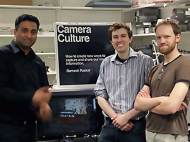HR3D – glasses-free 3D display using dual-stacked LCDs
 Researchers at MIT’s Media Lab have developed a new approach to glasses-free 3D displays, called High-Rank 3D (HR3D) Display, and they claim it could double the battery life of devices like the Nintendo 3DS without compromising screen brightness or resolution, expand the viewing angle of a 3D screen, and it would maintain the 3D effect even when the screen is rotated.
Researchers at MIT’s Media Lab have developed a new approach to glasses-free 3D displays, called High-Rank 3D (HR3D) Display, and they claim it could double the battery life of devices like the Nintendo 3DS without compromising screen brightness or resolution, expand the viewing angle of a 3D screen, and it would maintain the 3D effect even when the screen is rotated.
In the real world, as a viewer moves around an object the viewer’s perspective on it changes constantly. But with parallax-barrier used to achieve 3D, each new perspective further restricts light emission. Adding multiple perspectives in the vertical direction as well as the horizontal would require a parallax barrier with horizontal as well as vertical bands. Doug Lanman, a postdoc in Associate Professor Ramesh Raskar’s Camera Culture Group at the MIT Media Lab, along with postdoc Yun Hee Kim and graduate student Matthew Hirsch, decided to rethink glasses-free 3D from the ground up.
The MIT researchers’ HR3D system uses two layers of 120Hz Viewsonic LCD displays. But instead of displaying vertical bands (as the 3DS does), or pinholes (as a multiperspective parallax-barrier system would), the top LCD displays a pattern customized to the image beneath it. Instead of consisting of a few big, vertical slits, the parallax barrier consists of thousands of tiny slits, whose orientations follow the contours of the objects in the image.
Because the slits are oriented in so many different directions, the 3D illusion is consistent no matter whether the image is upright or rotated. Adding more perspectives changes the pattern of the slits, but they allow just as much light to pass. At the lowest quality setting, using a single frame on each display to produce a desired light field, the prototype could run at the full 120Hz, but it would result in very poor image quality. On the other hand, in order to accurately reproduce a full-rank 3×3 light field, the display would run at only 13Hz – a frequency below the flicker fusion threshold of the human eye.
In order to take the best of both extremes, the researchers suggest choosing a rate somewhere between these two. Interestingly, the rate that falls below the flicker fusion threshold for human vision will vary depending on lighting conditions. This means that the HR3D display can be run at lower rates/higher quality in low lighting conditions.
The researchers claim that if a device like the Nintendo 3DS used HR3D, its battery life would be longer, because the parallax barrier would block less light, the 3D effect would be consistent no matter the device’s orientation, and the display is able to show multiple perspectives in both the horizontal and vertical directions. However, HR3D is very computationally intensive. Aside the fact that computations require more processing power and consume more energy, the cost is higher compared to most of other available 3D technologies.
While Lanman acknowledges that the algorithm for calculating the barrier pattern is computationally complex, he believes that it can be refined so that it requires far less computation. He also points out that special-purpose chips designed specifically to run a refined version of the algorithm would consume much less power than a general-purpose processor performing the same computations.









Leave your response!